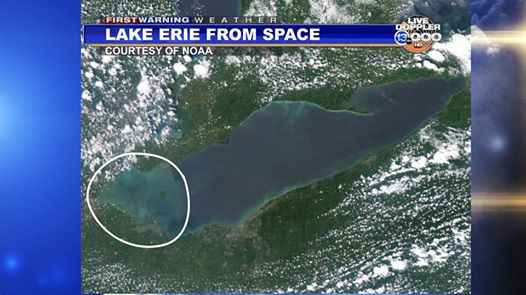First of all, news! I really want to brush up my Spanish and in particular my vocabulary related to food policy issues, so in the future I will try to include little summaries of the issue at hand in Spanish at the bottom of the post. You’ll be able to access them through a link on top of the page like this one:
It would be awesome if you told your (Hispanic) friends about it who are interested in these issues but would prefer to read about them in Spanish! And let me know if you find any mistakes 😀
————–
Did you hear? In Toledo, Ohio, over the weekend the population was warned not to drink the water from their taps. The reason? The algae bloom in western Lake Erie is so strong this year that it overwhelmed the city’s water-intake system. After a record bloom in 2011, which seriously affected much of the region’s economy related to water sports and fishing activities, there have been flare-ups summer after summer. This year’s bloom is not too bad in terms of scope, but the most intensive concentration of the algae is found exactly in the bay that Toledo derives its tap water from. This is problematic since the algae give off a toxin called microcystin, and tests of the water show that the concentration now is higher than the level permitted by the World Health Organization. It can cause nerve and liver damage both in people and animals. Thus, the city’s authorities over the weekend issued a warning statement affecting over half a million people to not drink the tap water, and not even to cook with it (since boiling the water only concentrates the toxin). It’s the second time that algae bloom has affected drinking water supply in the region after a period in September of last year.

A number of studies see a direct link between the farming practices in the surrounding areas – in particular, the high rate of fertilizer application in non-till fields that leave much of the nitrogen- and phosphorus-based fertilizer sit on the surface and run-off easily – and the levels of algae bloom in the recent past. Laura Johnson, a scientist at the National Centre for Water Quality Research, says:
“We know it’s coming from agricultural runoff. But in reality, when we think about why these farms are leaking phosphorus, that part of the story is far from clear and far from simple.”
There are currently no laws or regulations in place in Ohio that would govern the maximum level of fertilizer use or that address agricultural runoffs. As a first step, though, in spring farmers were offered voluntary training on fertilizer use before they applied it.
Researchers also say that climate change may be fueling the stronger algae blooms of recent years. This through increases in rainfall intensity, which can affect nutrient runoffs on the field, and warmer water temperatures, which give more favorable conditions for the algae to grow. Already, there is concern that the bloom will spread because September and October see even warmer water temperatures than now.
This issue is interesting because it exemplifies in monetary terms what we term “environmental externalities”, as the additional costs farming practices give society to bear. According to this article, “the city of Columbus spent nearly $800,000 getting rid of the rotten taste and smell in drinking water caused by nontoxic algae in Hoover Reservoir last winter. Toledo spent $3 million last summer keeping toxic algae out of the drinking-water supply there.” And Columbus is planning a $70 million treatment system to be finished in 2016 that will also deal with this contamination problem. These costs could be avoided if fertilizer levels were better controlled. Should there be greater levels of legal regulation? Jeff Reutter, an expert on toxic bloom, says:
“As much as anything, that is a question for society and for politicians. The question really becomes, ‘How long should we wait for voluntary practices to work?’ ”
This comic strip gives a great introduction to the issue of algae bloom in the Great Lakes and the way it’s affected their economy.
————–
¿Sabéis? En Toledo, Ohio, el fin de semana pasado avisaron a la población que no bebieran el agua del grifo a causa de niveles aumentados de una toxina llamada microcystin. En niveles concentrados, la toxina puede causar problemas de hígado y nervios para humanos y animales, y los autoridades encontraron niveles encima del nivel acceptable según la Organización Mundial de la Salud (OMS). ¿La causa de la polución? Una incidencia de floración de algas precisamente en la bahía dónde la ciudad derive su agua potable. El lago Erie ha visto problemas repetidos con floraciones de algas en los años pasados, sobre todo en el año 2011, cuando la extensión y duración de las algas afectó duramente la economía local ligada al turismo y la pesca. Aquí encontráis un webcomic en inglés que explica muy bien el problema de la floración de algas en el lago Erie. Como veis en la foto arriba, la contaminación se puede ver incluso desde el espacio. Investigadores ecológicos dicen que muy probablemente el crecimiento de los floraciones de algas es causada por las prácticas agrícolas en la región, sobre todo el uso de fertilizantes a base de fósforo que llegan al lago a través de escorrentía superficial. La agricultura sin labranza aumenta el porcentaje del abono que permanece a la superficie, y el cambio climático – que intensifica los precipitaciones y aumenta la temperatura de agua del lago, lo que da condiciones favorables a las algas – también desempeña un papel importante en el proceso. Según expertos, el gobierno debería controlar el uso de fertilizantes de una manera más intensivo, especialmente porque contaminaciones como ésta causan gastos reales a los ciudades, que tienen que pagar millones de dólares para purificar su agua potable.